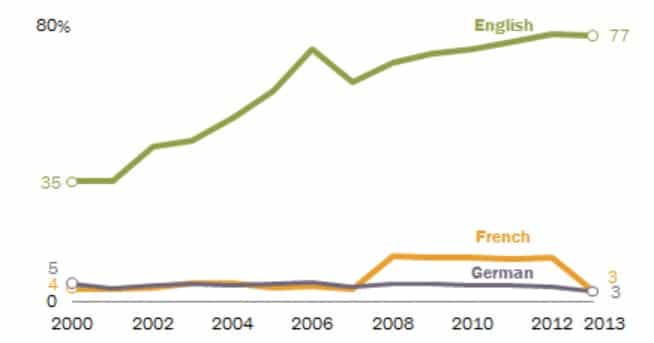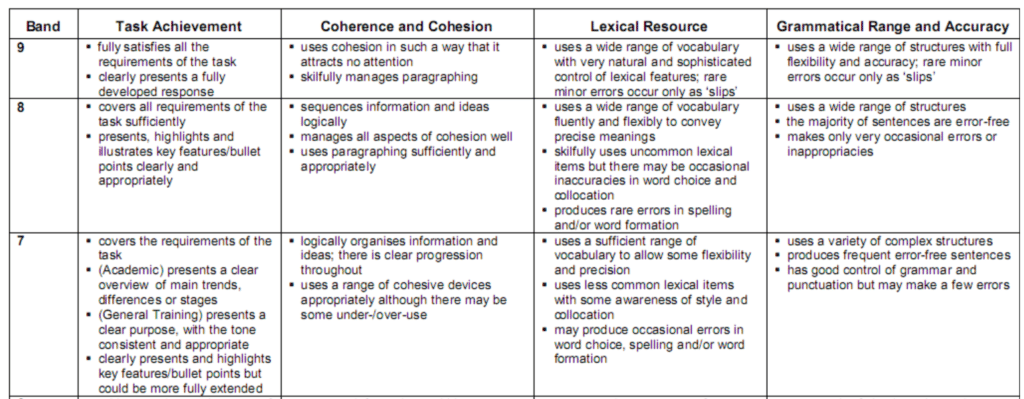IELTS Academic Writing Task 1

The IELTS test consists of the reading, listening, writing, and speaking sections. The writing section is divided into Task 1 and Task 2. In this guide, we will discuss Writing Task 1:
- Outline
- Scoring
- Sample
- Overall writing strategy
- Types of questions
- Writing strategies for each question type
Outline
Time: 20 minutes
Length: 150 words
Task: You will write about the given visual information (charts or diagrams).
Scoring
You will be evaluated according to
- Grammar – Is it accurate and varied?
- Vocabulary – Is it accurate and varied?
- Overall cohesion – Are your ideas organised logically?
- Task achievement – Did you fully describe the visual information?
Below, you can see the official band 9 requirements for IELTS Writing Task 1.

Task 1 Sample
You should spend about 20 minutes on this task.
The line graph shows the languages studied in primary schools.
Summarize the information by selecting and reporting the main features and make comparisons where relevant.
Write at least 150 words.
Language Studied by Primary School Students

Overall Writing Strategy
You only have 20 minutes and 150 words, but in that time and space, you need to achieve 3 basic objectives:
1. Define the Chart or Diagram
Start with one or two sentences that describe the chart or diagram. Include the information of the title, but don’t copy. Be sure to include:
- The type of visual information eg. pie chart, bar chart, line graph, diagram, table
- The time frame eg. …. from 2000 to 2013
- The element being observed eg. English, French, and German
- Don’t discuss the trends or implications here. Only define the chart or diagram
For our sample question, a good introduction might be:
This line graph describes the the study of the English, French, and German languages by primary school students from 2000 to 2013.
Note:
- We do not copy the exact words of the title. You can lose marks for copying as it shows that you don’t have the flexibility to reword statements.
- All the necessary elements (dates, data sets, chart type) are given
2. Give an Overview
In your second paragraph, you can give an overview of the chart. You should talk about the main trends or findings. Don’t give details here. At this stage, we just want a bird’s eye view of the information.
Sample question example:
Overall, the study of the English language by primary students doubled over the 13 years. It grew at a much faster rate than the study of German or French, which remained relatively constant.
Note:
- There are almost no numbers or specifics
- Despite the lack of detail, we still have a good understanding of what the chart represents
3. Give the Detail
In these paragraphs, you can give the finer specific details of the chart. Be sure to be as specific as possible by referencing actual numbers and dates. You should look for patterns, similarities, differences, and other notable observations.
Looking at our sample question, we can find:
- In 2000, English is at 35%, while French and German are at 4% and 5%
- In 2000, English is almost 10x more than the other two languages.
- In 2006, English peaks, then rapidly falls about 10%
- In 2013, both French and German are at lower positions than they were in 2000
- From 2008 to 2012, the number of primary students studying French roughly doubled before suddenly dropping in 2013
Sample question example:
Let’s put all this info into paragraph form.
In 2000 English was already showing strength, sitting at 35%, which was more than 10 times the study of French and German at elementary schools at that time. In 2000, only 4% studied French while 5% studied German. The study of German and French did not fare much better over the years, with only minor movements which ended in 2013 at 3%, even lower than where they started.
The growth of English was not always straight forward. One example of this was in 2006, where after peaking, it suddenly dropped 10% before resuming its rise.
The study of the French language showed some promise between 2008 and 2012 where it doubled, however in 2013 its study suffered a precipitous decline.
Notes:
- French and German are often grouped together. Even though they differ from each other, they act similarly when compared to French.
- Exact numbers and approximate numbers are widely used
- Language is used to summarise the trend (eg. In 2000 English was already showing strength…. The study of German and French did not fare much better over the years…. The growth of English was not always straight forward)
4. Conclusion
Conclusions are not necessary for Task 1 questions, however, if you can add an appropriate conclusion, it would certainly make your answer more complete and better structured. You have a few options for conclusions:
- Summarise the main trends
- Frame the information in a different light
Sample question example:
English is the most dominant language in the world, and it has not shown any signs of slowing down.
Note:
- The information from our answer is not repeated here.
- The exact words from our answer is not repeated here.
5. Example Answer
This line graph describes the the study of the English, French, and German languages by primary school students from 2000 to 2013.
Overall, the study of the English language by primary students doubled over the 13 years. It grew at a much faster rate than the study of German or French, which remained relatively constant.
In 2000 English was already showing strength, sitting at 35%, which was more than 10 times the study of French and German at elementary schools at that time. In 2000, only 4% studied French while 5% studied German. The study of German and French did not fare much better over the years, with only minor movements which ended in 2013 at 3%, even lower than where they started.
The growth of English was not always straight forward. One example of this was in 2006, where after peaking, it suddenly dropped 10% before resuming its rise.
The study of the French language showed some promise between 2008 and 2012 where it doubled, however in 2013 its study suffered a precipitous decline.
English is the most dominant language in the world, and it has not shown any signs of slowing down.






